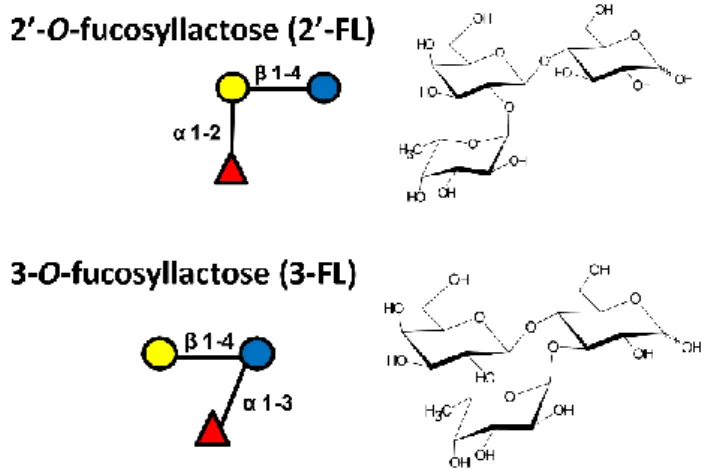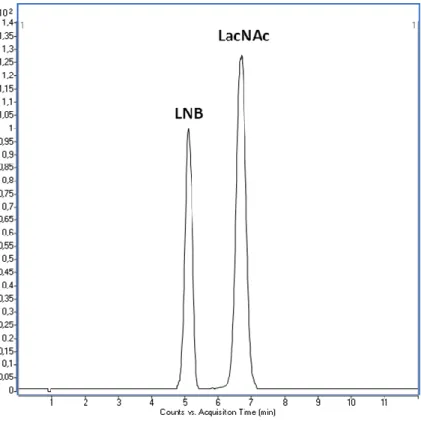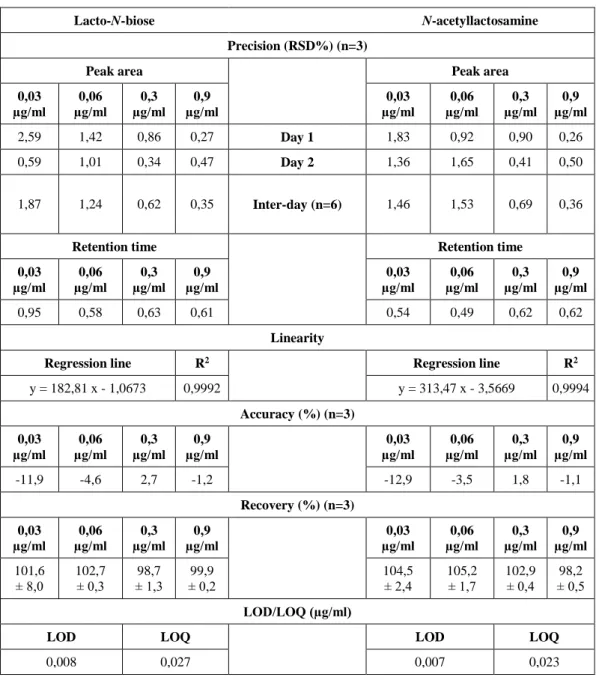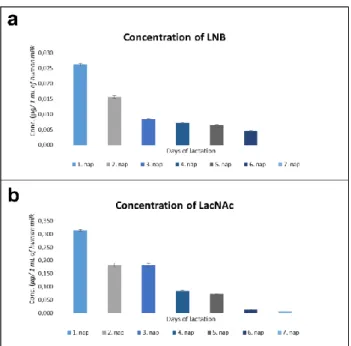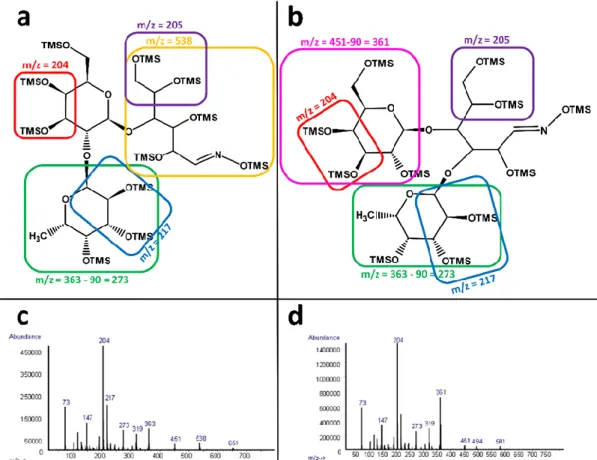Analytical characterisation of human milk oligosaccharides
Ph.D. thesis
Réka Balogh
Semmelweis University
Doctoral School of Pharmaceutical Sciences
Supervisor: Szabolcs Dr. Béni, Ph.D.
Opponents: Anikó Dr. Zsigrainé Dr. Vasanits, Ph.D.
Huba Dr. Kalász, Ph.D.
Final Exam Committee
Chairman: Tamás Dr. Török, C.Sc.
Members: Pál Dr. Perjési, C.Sc.
Krisztina Dr. Ludányi, Ph.D.
Budapest
2018
1
Introduction
Importance of breastfeeding is in the focus of both everyday conversations and scientific discussions. However, it is not a coincindence, as more and more research data point out the complex and unique composition of human milk which is - by its countless health benefits - considered to be the gold standard of nutrition for infants.
Human milk contains besides the three major components - lipids, proteins and lactose – oligosaccharides in an amount that is not only comparable to the major components, but also exceeds the amount of proteins. While the previously mentioned components play an important role in nourishing the infant, the unjonjugated and structurally divers group of oligosaccharides are undigestible for the infants. Hence, their function is in a major focus as synthesis of huge amounts of worthless components would be an unambiguous energy loss for the mother. In the last decades more and more research groups started to focus on the investigation of the functions of oligosaccharides. As a result of it, it is already known that they have an impact on the composition of the infants’ intestinal microbiota, protect the infant against several pathogens (Campylobacter jejuni, Vibrio cholerae, Streptococcus pneumoniae etc.), possess immunmodulatory effects, lowers the incidence of necrotising enterocolitis (NEC) which is an often life-threatening disorder amongst premature infants, promotes the development of infants’
brain and can also prevent the mother against some pathogens.
Despite the growing number of structurally identified oligosaccharides, of which some of them also has an already known, exact biological function, the exact structure of the more than 200 unique oligosaccharides detected in human milk (and their biological role) is still need to be indentified. Nowadays the pharmaceutical/food industry tries to give better and more complex alternatives for human milk by the enrichment of infant formulas with oligosaccharides. However, for producing a product as unique as human milk, knowledge of most of the still unknown structures, their quantitative attributes and their biological functions are inevitable. The complex and always (from day to day and from individual to individual) changing compsition of human milk may never be mimiced artificially. However – also by the work of our research group – useful information about oligosaccharides can be obtained to develop infant formulas specific for the treatment of certain diseases.
2
Aims
1) Identification and quantification of the disaccharide building blocks
The aim of our work was to detect and quantify the two major building blocks of milk oligosaccharides, LNB and LacNAc in colostrum samples for the very first time. These highly related disaccharide structures differ only in the linkages between the galactose and the N- acetylglucosamine residue: whilst in the case of LacNAc it is a β1–4 linkage, in the LNB structure the galactose is linked with a β1–3 glycosidic bond to the N-acetylglucosamine (Figure 1.). Moreover, they have the same molecular weight (383.4 g/mol) and possess rather poor UV activity. The subtle structural difference results in very similar chromatographic features, hence their separation is challenging.
Figure 1. - The schematic structure of the lacto-N-biose (LNB) and the N-acetyllactosamine (LacNAc) by the Consortium for Functional Glycomics along with the structure of the disaccharides.
Our hypothesis is that the presence of non-bound LNB and LacNAc in the colostrum and the human milk cannot be a coincidence. Hence, if LNB and LacNAc are found in human milk samples, it can possibly predict important biological functions which make them important target molecules: their identification in human milk can possibly lead us closer to the understanding of HMO biosynthesis or reveal brand new biological functions. Their identification and quantification could also be important for the artificial nutrition industry to assemble infant formulas which can better mimic the composition of human milk. Besides their biological relevance the challenging analytical problem to separate and to quantify such highly related structures from biological matrices has driven our interest to the research of these compounds.
2) Determination and quantification of the trisaccharides
The aim of our study was to develop a GC–MS method for the identification and quantification of 2’-O-fucosyllactose (2’-FL) and 3-O-fucosyllactose (3-FL) (Figure 2.). 2’-FL is the most abundant oligosaccharide in the human milk (except in the milk of non-secretor mothers where 2’-FL is not presented at all due to the lack of α1-2 fucosyltransferase enzyme).
Its linkage isomer 3-FL is found to be in far less amounts, however still contributing to a major part of the total oligosaccharide content of human milk.
3
Figure 2. - The structure of the 2’-O-fucosyllactose and 3-O-fucosyllactose (b) and their schematic structure by the Consortium for Functional Glycomics.
Besides their significant presence in human milk, their possible biological functions also make them important targets for our studies. Prebiotic effects and the inhibition of the enterohepatogenic Escherichia coli and Pseudomonas aeruginosa seem to be characteristic to both trisaccharides, while the inhibition of Campylobacter jejuni and Salmonella enterica s.
fyris is typical for the 2’-FL. 2’-FL can also hinder the growth of numerous Enterobacteriaceae strains which may contribute to the intestinal inflammations and the development of necrotizing enterocolitis (NEC). As both the chemical and enzymatic synthesis of 2’-FL and 3-FL is relatively straightforward compared to the more complex oligosaccharides, and as 2’-FL and 3-FL are found in significant amounts in the human milk, these compounds are among the first and most promising candidates for the infant formulas to be enriched with.
4
Methods
1) Identification and quantification of the disaccharide building blocks
Human milk samples collected at postpartum periods were donated to our research group from healthy individuals. Standards of LNB and LacNAc were provided by Elicityl SA and Carbosynth Limited, respectively. HPLC experiments and validation were performed on an Agilent1100 HPLC system. Mass spectrometricanalyses were performed with an Agilent 6410B triple quadrupole mass spectrometer with an electrospray ionization source (ESI).
The milk samples (10 mL) were subjected to liquid–liquid extraction with 4 volumes (40 mL) of a chloroform–methanol (2:1, v/v) mixture. The mixture was vortexed for 5–10 min and the emulsion obtained was centrifuged for 30 min at 3139 × g (6000 rpm) with a SIGMA Sartorius 2-16P centrifuge. The upper phase was then collected and the lower chloroformic phase and the denatured protein were discarded. The whole procedure was repeated with the upper phase to ensure the removal of all fat and protein from the sample. The sample was dissolved in 500 µL of distilled water and subjected to size-exclusion chromatography in order to separate the predominant lactose from other saccharides and also to fractionate the saccharides by their size. 1.0 M NaBH4 solution was used to reduce LacNAc/LNB to their alditol form. For this purpose, previously lyophilized samples were dissolved in 200 µL of deionized water. After the addition of 200 µL of 1.0 M NaBH4 the solutions were incubated in a water bath at 65°C for 90 min. After the reduction step, solid-phase extraction by a non-porous graphitic carbon cartridge was used to remove borate salts.
For the separation a Hypercarb (5 µm; 100 x 2,. mm) column has been used. Column has been kept at constant 25 °C. Water containing 0.1 % V/V HCOOH has been used as mobile phase A and methanol as mobile phase B, respectively. Isocratic elution profile has been performed of 3% methanol and 97% water containing 0.1 v/v% HCOOH at a flow rate of 0.5 mL/min and 12 mins analysis time. For retention time stability each run has been followed by a washing protocol. Nitrogen has been used as collision gas, mass spectra has been collected in positive ionization mode. The precursor ion m/z 408 – which is the sodium adduct of the reduced sugars, [M+Na]+ – resulted in two major fragments. The fragment m/z 246 achieved by fragmentor voltage 210 V and collision energy 28 V has been choosen for quantification, while m/z 228 has been used for qualification for both LNB and LacNAc, respectively. The fragmentation pattern is the same for both compounds and there are no selective fragment ions has been found to distinguish the compounds from each other. Quantification has been performed by multiple reaction monitoring (MRM) mode.
The method was validated in accordance with the corresponding European Medicines Agency (EMA) guideline.
2) Determination and quantification of the trisaccharides
Standards of 2’-FL and 3-FL were provided by Glycom A/S. Human milk samples collected at postpartum periods were donated to our research group from healthy individuals.
A 5 mL aliquot of each milk sample was defatted and proteins were precipitated by adding 20 mL mixture of chloroform/methanol (2:1, v/v) and vortex-mixing for 5 min. Samples were then centrifuged at 6000 rpm for 30 min. The lower organic phase was discarded and the upper
5
aqueous phase was re-extracted in the similar fashion. For subsequent derivatization the upper aqueous phase was used.
50–100 µL milk extracts or aqueous standard solutions were dried at 30°C under vacuum. Each sample residue was dissolved in 125 µL pyridine containing 2.5 g/100 mL hydroxylamine and was heated for 30 min at 70°C. The cooled samples were then trimethylsilylated with a mixture of 225 µL HMDS and 25 µL TFA for 60 min at 100°C. The reaction mixture was allowed to cool down to room temperature and then was filtered through a 0.2 µm RC membrane syringe filter.
The analysis was carried out with an Agilent 6890N/5973GC–MSD equipped with a CTC Combi PAL automatic multipurpose sampler. Separation was performed using a Supelco SLB-5ms capillary column (30 m × 250 µm i.d., 0.25 µm film thickness). The GC oven temperature was programmed from 200°C (2 min isothermal) to 325°C at 4°C/min and finally held for 7.25 min. Helium was used as carrier gas at a flow rate of 1.0 mL/min in constant flow mode. Hot needle injection was performed with 3 and 2 s pre and post injection delay times, respectively. Injection volume was set to 1.0 µL and an additional 1.0 µL air gap was applied after sampling to empty the syringe needle before injection. The injector temperature was programmed from 200 to 320 °C at 720°C/min and a 40 psi pressure pulse was applied for 1.7 min while splitless time was set to 1.5 min.
The mass selective detector was equipped with a quadrupole mass analyzer and was operated in electron ionization mode at 70 eV. For identification the MS was operated in full scan mode (m/z 40–800 at 2 scan/s). The absolute quantification of 2’-FL and 3-FL was achieved by selected ion monitoring. 2’-FL and 3-FL were monitored at m/z 204 and 361, respectively.
The method was validated in accordance with the corresponding European Medicines Agency (EMA) guideline.
6
Results
1) Identification and quantification of the disaccharide building blocks
Baseline separation of the regioisomers was achieved with an isocratic elution profile of 3% methanol and 97% water containing 0.1 v/v% HCOOH (Figure 3.)
3. ábra - The chromatogram of the standards obtained with the developed method: H2O containing 0.1 v/v% HCOOH as mobile phase A, methanol as mobile phase B at a flow rate of 0.5 mL/min.
The use of HCOOH as an additive in the aqueous phase resulted in sharper chromatographic peaks and increased the efficiency of the ionization in the mass spectrometer.
No significant variation of the retention times was observed after the application of the developed washing procedure in which high amounts of organic solvent (methanol 90%) has been used to regenerate the stationary phase. By the use of the Agilent MassHunter Optimizer software fragment m/z has been choosen for quantification and m/z 228 has been choosen for qualification for both LNB and LacNAc, respectively. No selective fragments has been found.
Validation data are presented in Table 1.
Donated human milk samples from the first week of lactation from a healthy individual were studied. We were able to detect and quantify the LacNAc and also the LNB. The concentration of the LacNAc decreased from 310 µg/mL of human milk to 6.7 µg/mL of human milk, while the concentration of the LNB decreased from 26 µg/mL of human milk to below the LOD. All of the final concentrations were corrected (using dilution factors) and are given as mg/mL human milk (Figure 4.).
7
Table 1. - Method validation data: precision, linearity, accuracy, LOD and LOQ of the lacto-N-biose and N- acetyllactosamine.
Lacto-N-biose N-acetyllactosamine
Precision (RSD%) (n=3)
Peak area Peak area
0,03 µg/ml
0,06 µg/ml
0,3 µg/ml
0,9 µg/ml
0,03 µg/ml
0,06 µg/ml
0,3 µg/ml
0,9 µg/ml
2,59 1,42 0,86 0,27 Day 1 1,83 0,92 0,90 0,26
0,59 1,01 0,34 0,47 Day 2 1,36 1,65 0,41 0,50
1,87 1,24 0,62 0,35 Inter-day (n=6) 1,46 1,53 0,69 0,36
Retention time Retention time
0,03 µg/ml
0,06 µg/ml
0,3 µg/ml
0,9 µg/ml
0,03 µg/ml
0,06 µg/ml
0,3 µg/ml
0,9 µg/ml
0,95 0,58 0,63 0,61 0,54 0,49 0,62 0,62
Linearity
Regression line R2 Regression line R2
y = 182,81 x - 1,0673 0,9992 y = 313,47 x - 3,5669 0,9994
Accuracy (%) (n=3) 0,03
µg/ml
0,06 µg/ml
0,3 µg/ml
0,9 µg/ml
0,03 µg/ml
0,06 µg/ml
0,3 µg/ml
0,9 µg/ml
-11,9 -4,6 2,7 -1,2 -12,9 -3,5 1,8 -1,1
Recovery (%) (n=3) 0,03
µg/ml 0,06
µg/ml 0,3
µg/ml 0,9
µg/ml 0,03
µg/ml 0,06
µg/ml 0,3
µg/ml 0,9 µg/ml 101,6
± 8,0
102,7
± 0,3
98,7
± 1,3
99,9
± 0,2
104,5
± 2,4
105,2
± 1,7
102,9
± 0,4
98,2
± 0,5 LOD/LOQ (µg/ml)
LOD LOQ LOD LOQ
0,008 0,027 0,007 0,023
8
Figure 4. - Concentration changes of LNB (a) and LacNAc (b) in a human milk sample in the first week of lactation.
Concentrations are corrected with the dilution factors, the recovery values and are given to 1 mL of human milk sample.
2) Determination and quantification of the trisaccharides
Analyzing the fragmentation pattern of the standards of each trisaccharide (Figure 5.) characteristic fragments for both compounds has been found such as m/z 73, m/z 90, m/z 363, m/z 273, m/z 204 and m/z 217, respectively. Although the two structures are very similar, therefore similar fragmentation behavior can be seen on the mass spectra, due to the difference in the position of the fucose moiety, we aimed to identify isomer specific fragments, which could be used for quantification. Selective fragment for 2’-FL is m/z 538, while fragments m/z 451 and m/z 361 are characteristic to 3-FL.
Besides identifying selective fragments, baseline separation of the compounds was inevitable which has been achieved by the developed method. The reasonable separation from lactose is a remarkable advantage of this method as it allows the direct analysis of HMO samples without previous time consuming sample preparation steps.
Validation data are presented in Table 2 and Table 3.
During our work we were able to identify and quantify 2’-FL and 3-FL in human milk samples from two healthy individuals (donor A and donor B) from the first week of lactation.
In the case of donor A the concentration of the 2’-FL varied between 4525 µg/mL and 6266 µg/mL, and for 3-FL the concentration varied between 271 µg/mL and 441 µg/mL (concentrations are given to the human milk samples corrected with dilution factors and recovery data). In the case of donor B these values were 2694 µg/mL and 3551 µg/mL for 2’- FL, and 99 µg/mL and 208 µg/mL for 3-FL, respectively (Figure 6.). Tendency of the concentration changes cannot be outlined: in the first week of lactation the concentration of the two compounds in both milk samples shows relative constant concentrations. Additionally, 3- FL concentration was 154 and 204 µg/mL, and 2’-FL was 3070 and 2698 µg/mL in samples collected from donor B after 1 and 2 monthsof delivery, respectively.
9
Figure 5. - Proposed fragmentation patterns and mass spectra of the trimethylsilyl oxime derivatives of the 2’-O- fucosyllactose (a and c) and 3-O-fucosyllactose (b and d).Generally speaking m/z 73 refers to the TMSO radical ion, while
the mass difference with an m/z 90 refers to the neutral loss of TMSOH.
Table 2. - Precision and accuracy of the assay developed for the quantification of 2’-FL and 3-FL.
Concentration 2'-FL 3-FL
(µg/ml) Precision Accuracy Precision Accuracy
2'-FL 3-FL (RSD%) (%) (RSD%) (%)
42 2 0,3 6,0 1.3 -3,7
167 17 2,4 3,1 3.2 9,8
333 33 0,7 -1,3 4.8 -3,4
Table 3. - Recoveries of human milk oligosaccharides spiked into human milk.
Spike levela 2'-FL (%) 3-FL (%)
1 22 ± 1 22 ± 2
2 29 ± 5 27 ± 6
3 27 ± 1 24 ± 1
Mean recovery 26 ± 4 25 ± 3
aFor 2’-FL spike level 1 was 1 mg/mL, spike level 2 was 2 mg/mL and spike level3 was 8 mg/mL; for 3-FL these values were 0.1 mg/mL, 0.2 mg/mL and 0.8 mg/mL,respectively.
.
10
Figure 6. - Concentration changes of 2’-O-fucosyllactose (a) and 3-O-fucosyllactose (b) during the first week of lactation.
Black dots represent data of donor A, black diamonds belongs to donor B.
11
Conclusion
1) Identification and quantification of the disaccharide building blocks
Our work has not only focused on developing a suitable method but also to analyze human milk samples. Donated human milk samples from the first week of lactation from a healthy individual were studied as based on literature the oligosaccharides commonly show the highest concentration around the time of partum and decrease throughout time. We were able to detect and quantify the LacNAc and also the LNB. To the best of our knowledge no previous data were reported in the literature on the presence of unbound LNB and on the concentration of both compounds in human milk. The concentration of the compounds showed a significant drop after the first day of lactation and this decreasing tendency continued until the end of the first week when the concentration of the LacNAc reached the limit of quantification and the concentration of the LNB was not even detectable. The concentration of the LacNAc decreased from 310 µg/mL of human milk to 6.7 µg/mL of human milk, while the concentration of the LNB decreased from 26 µg/mL of humanmilk to below the LOD.
In human milk, naturally the type I oligosaccharides – which contain LNB linked lactose units – dominate over the type II oligosaccharides where LacNAc is the building block linked to the lactose. This is a feature specific to the human breast milk. Milk of other mammals and especially primates (new and old world monkeys and apes) contain predominantly or exclusively type II oligosaccharides which makes the predominance of type I oligosaccharides a hominoid feature. Interestingly, the ratio of unbound LNB and LacNAc is the opposite of the ratio of type I and type II oligosaccharides. This phenomenon however, requires further studies.
The detection of unbound LNB and LacNAc can suggest that during the biosynthesis elongation of the lactose core can be performed by lacto-N-biose and N-acetyllactosamine blocks instead of monosaccharides or more complex structures. Hopefully, our results can reveal new options of the biosynthesis of HMOs.
2) Determination and quantification of the trisaccharides
Based on the results discussed previously, the concentration of both 2’-FL and 3-FL was fairly constant in the first week of lactation, and based on the samples collected from donor B their concentration has not changed significantly after 1 and 2 months of partum. These data suggest, that the production and excretion of these two trisaccharides into the breastmilk are maintained at a fairly similar level even after longer time periods.
In a recent study it has been suggested that the 2’-FL/3-FL ratio of over 6.5 can be the specific marker of the individuals who possess secretor status (i.e., expressing the fucosyltransferase 2 enzyme). The 2’-FL/3-FL ratio in the case of the two individuals studied herein was found to be 15 and 20 for donor A and donor B, respectively. Accordingly, both individuals are secretors. However, it is well-known that huge differences can be found between the individuals’ milk depending on their diet, lifestyle, ethnicity and the day of lactation etc.
which can attribute to the different ratios as observed in our study as well.
12
Publication list
Publications covering the theme of the thesis
1) Qualitative and quantitative analysis of N-acetyllactosamine and lacto-N-biose, the two major building blocks of human milk oligosaccharides in human milk samples by high-performance liquid chromatography–tandem mass spectrometry using a porous graphitic carbon column, R. Balogh, P. Jankovics, Sz. Béni, Journal of Chromatography A, 1422 (2015) 140-146.
2) Determination and quantification of 2’-O-fucosyllactose and 3-O-fucosyllactose in human milk by GC–MS as O-trimethylsilyl-oxime derivatives, R. Balogh, Sz. Szarka, Sz. Béni, Journal of Pharmaceutical and Biomedical Analysis, 115 (2015) 450-456.
3) Analytical characterization of human milk oligosaccharides - potential applications in pharmaceutical analysis, M. Grabarics, O. Csernák, R. Balogh, Sz. Béni, Journal of Pharmaceutical and Biomedical Analysis, 146 (2017) 168-178.
4) Az anyatej oligoszacharidok szerkezete, vizsgáló módszerei és biológiai szerepe. R. Balogh, Á. Rácz, Sz. Béni, Gyógyszerészet, 56(1) (2012) 18-23.
Other publications
1) Design and evaluation of cyclodextrin-based delivery systems to incorporate poorly soluble curcumin analogs for the treatment of melanoma, D. Michel, J. M. Chitanda, R. Balogh, P. Yang, J. Singh, U. Das, A. El-Aneed, J.
Dimmock, R. Verrall, I. Badea, European Journal of Pharmaceutics and Biopharmaceutics, 81(3) (2012) 548-556.
2) Permeability test for transdermal and local therapeutic patches using Skin PAMPA method, G. Vizserálek, Sz.
Berkó, G. Tóth, R. Balogh, M. Budai-Szűcs, E. Csányi, B. Sinkó, K. Takács-Novák, European Journal of Pharmaceutical Sciences, 76 (2015) 165-172
13
Acknowledgement
I would like to thank Dr. Horváth Péter and Professor Dr. Noszál Béla, the present and former heads of the Semmelweis University Department of Pharmaceutical Chemistry for the opportunity to perform my PhD studies, and previously my TDK work in their Department.
My sincere thanks go to my supervisor Dr. Béni Szabolcs who has brought my interest to separation sciences through the theme of the project and who guided and supported me throughout my PhD work. I would like to say many thanks to Dr. Jankovics Péter, Dr. Szarka Szabolcs, Dr. Alberti-Dér Ágnes and Dr. Tóth Gergő for their professional support and guidance, without their help this PhD thesis would not come into existence
I would like to thank the two TDK students, dr. Grabarics Márkó and dr. Tóth András that they have approached the emerging scientific problems in a different perspective and with their diligence they gave further impulse for our research.
I owe thank for the further co-workers of the Deparment of Pharmaceutical Chemistry as well as the Department os Pharmacognosy for their professional and personal relationships.
I would like to say many thanks to my supervisors and co-workers of the National Institute of Pharmacy and Nutrition that they supported me in finishing my PhD work and who inspired me professionally and personally, too.
Most of all my heartfelt thanks go to my family. To my parents who have supported me and led me in my whole life so far, and without whom – besides many other things – my PhD thesis would never come into existence. I would like to thank my son, Vizserálek Zsombor that he brings smile to my face every single day and keeps me motivated to set a good example for him. Last but not least, I would like to say many thanks to my husband, Dr. Vizserálek Gábor who is a real partner in life and who always supports and stands by me whatever comes into our way.

